



How Breeding Companies Help Improve Broiler Industry Efficiency
Poultry genetic companies have responded through an unprecedented testing of all breeding lines, writes Mike Donohue of Agri Stats in the latest issue of Cobb's Business Focus.The ongoing improvement in broiler production efficiency over the last 20 years is astounding. Producers expect to see gains in growth rate, feed conversions and meat yields. Average broiler hatchability, an indicator of reproductive performance, has surprisingly also improved over the last five years. This is largely a result of work done by the broiler genetic companies.

While there are obvious eventual limits to the amount of performance gain we can expect in the future, no one expects the industry to ever hatch a four lb chicken; we still can expect to see continuing annual improvements in production in coming years. These improvements come from a combination of genetics, industry focus on animal husbandry programs and ongoing work in all areas of processing plant operations.
Genetic selection programs in the US poultry industry go back to the early part of the 20th century. In the beginning of the industry perhaps hundreds of small operations across the country were active in selective breeding programs to separate poultry lines for egg production or broiler production. As time progressed certain breeding programs were recognized for producing superior lines that focused on the industry needs of the era and these companies grew into the poultry genetics companies that exist today to serve the needs of broiler and egg producers worldwide.
In the 1960s through the 1980s, most of the focus in broiler selection programmes was on criteria that were relatively easy to measure including egg production, hatchability, growth rate and feed conversion. Serving a market that largely produced bone-in chicken that was consumed in the home, selection for the live production characteristics resulted in annual improvements in live cost of production.
As the demand for food service and further processed items increased in the 1990s and into this decade, greater focus in genetic selection programmes was placed on processing characteristics including eviscerated yield and most importantly deboned breast meat yields. Growth rate and calorie conversions continued to improve and the breeder characteristics like egg production and hatchability maintained the gains seen in earlier years.
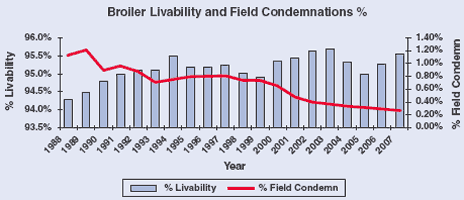
During the last 15 years, the time it takes to get a broiler to a 5.0 lb (2.3 kg) live weight has decreased by more than a week. Birds get to target weights 16.3 per cent sooner than they did in 1992. The industry continues to see another day of improvement every two years. The benefit of better growth rate is improved feed conversion. The sooner birds get to desired market size, the higher the percentage of feed consumed goes to muscle development instead of body maintenance. Conversion ratios decline as birds get older and more of the feed they consume is used for maintenance.
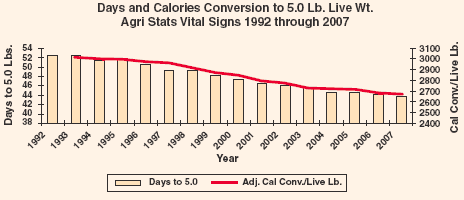
Over the same period of 15 years, calorie conversions have improved by 12 per cent from 3018 calories of feed per live lb to 2672 calories of feed per live lb. Every one per cent of improvement decreases calorie demand per lb of live weight by 27 calories. At current feed costs of $260 per ton or approximately $0.26 per live lb, a one per cent improvement in feed cost per live lb in the US industry producing 49,000,000,000 lb is worth $127,400,000. The 12 per cent gain seen over the last 15 years at current feed costs has brought over $1.5 billion in benefits to the US industry alone. Worldwide, the effect would more than quadruple.
The gain in production efficiency has been accompanied by improvements in broiler livability and other areas of poultry health including field caused condemnation or mortality levels.
Twenty years ago, the industry grew a chicken to a 4.3 lb/1.95 kg live weight at processing. By 2007, the average live weight at processing increased by 37 per cent to 5.9 lb/2.7 kg as more and more chickens were used for further processing using big birds.
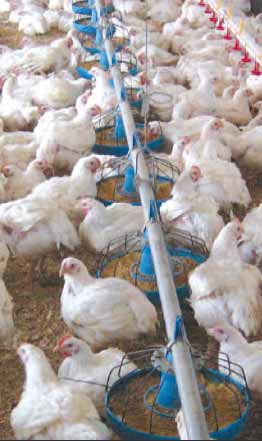
Over the same period, average broiler livability improved from 94.3 per cent to 95.6 per cent and field caused whole bird condemnations or mortality dropped from 12 per 1000 to fewer than 3 per 1000.
Poultry husbandry programmes, improved conditions and better ventilation in poultry housing have contributed to these gains, but the poultry genetic companies have also focused on issues that contribute to these gains in productivity. More tools have become available to the genetic companies including knowledge of the genome of the chicken that allow the geneticists to include more measures of poultry health in their selection programs. The gains in these areas promise to be spectacular in the future.
As the broiler processing industry matured, more and more focus was placed on meat yields, the percentage of saleable pound (or kg) of meat that could be processed from each chicken that comes to the processing plant. In the 1990s, further processing demanded more and more breast meat to meet the changing demands of consumers for wholesome products that were easy to prepare and tasted good as well.
Genetic companies responded by focusing the genetic selection on breast muscle deposition and the percentage of breast meat of the total live weight of the chicken has increased dramatically. Part of the increase is due to the heavier bird weights used in today’s industry.
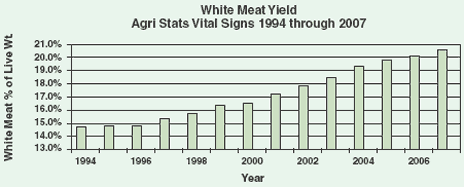
Every lb (454g) of bird weight increases eviscerated yields by one per cent as a percentage of live weight and the majority of this increase comes in the form of deboned breast meat, the focus of the genetic selection programmes.
Genetic selection programmes typically indicate that they have a goal of improving breast meat yields as a percentage of live weight. These goals are normally improved by 0.3 to 0.4 per cent in each generation. Over a ten-year period, we would expect to see eviscerated yields and breast meat yields improve by 3 to 4 per cent. Actual results over the last ten years in the US show eviscerated yields improving by 4.3 per cent and boneless breast meat yields have improved by over 5 per cent as a percentage of live weight.
For every 100 lb (45.5 kg) of live chicken going to a deboning plant in 1997, the plant would generate 15.4 lb (7.0 kg) of breast meat if every front half was deboned. A plant producing 1.3 million chickens weekly with a live weight of 4.96 lb (2.25 kg) and a 15.4 per cent breast meat yield would have 992,992 lb (451,360 kg) of breast meat to sell.
Fast forward ten years. In 2007, the same plant processing 1.3 million chickens a week, now with a live weight of 5.93 lb (2.7 kg) and a boneless breast meat yield of 20.54 per cent would now have 1,583,429 lb (719,740 kg) of breast meat to sell, an increase of 590,437 lb (268,380 kg). If breast meat is sold for $1.40 per lb ($3.08 per kg) – a reasonable year on year estimate over the period – then the average deboning plant gains over $826,000 weekly in breast meat sales revenue only slightly offset by a decline in rendering revenue, as more of the live weight is sold in the form of meat instead of offal.
From 1990 to 1998, the industry suffered a significant decline in average hatchability.
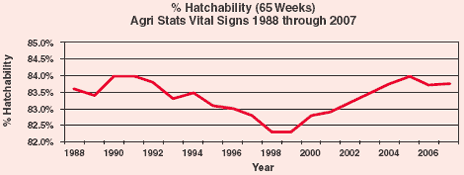
Hatchability is the measure of the percentage of chicks hatched from every 100 hatching eggs set in incubators. The causes of the decline in hatchability were attributed to changes in the breeds used in the industry as well as difficulties in managing male weights in the breeder population, which resulted in lower fertility percentages.
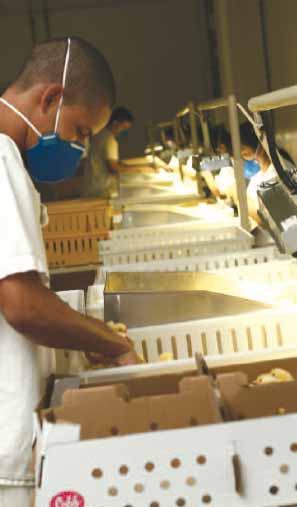
In 1997, the industry was affected by a change in the virulence of the 'J' strain of the leucosis virus that attacked breeder pullets and breeder hens across most of the breeds available to hatching egg producers. Pullet mortality more than tripled from 4 per cent to 14 per cent during the growing period from day-old to 25 weeks of age and the onset of hatching egg production. Producers also experienced higher than expected mortality during the 40-week laying period causing economic loss for the industry and an increase in the cost of production for hatching eggs.
The poultry genetic companies responded through a massive and unprecedented testing of all their breeding lines back through the pedigree level which eradicated not just the 'J' virus but indeed all leucosis viruses from their primary breeding programmes. As a result, the general health of the breeding stock improved, mortality levels recovered and indeed even improved over time and hatchability rebounded to the highest levels seen in over a decade.
The work of poultry genetic companies in concert with the efforts of all other parts of the production chain has resulted in continuous improvement in efficiencies, costs of production and industry profitability.
The pace of improvement has not diminished and geneticists today have even newer tools in their hands to make further gains in the areas of poultry health and welfare, feed conversion efficiencies and meat yields. The value will continue to increase in coming decades.
For over 10 years, Mike Donohue has been with Agri Stats, working with US, Canadian and international broiler companies. Previously, he was with Arbor Acres Farms, including a period as vice president of marketing. He has a BA in political science and an MS in food and resource economics.
February 2009








